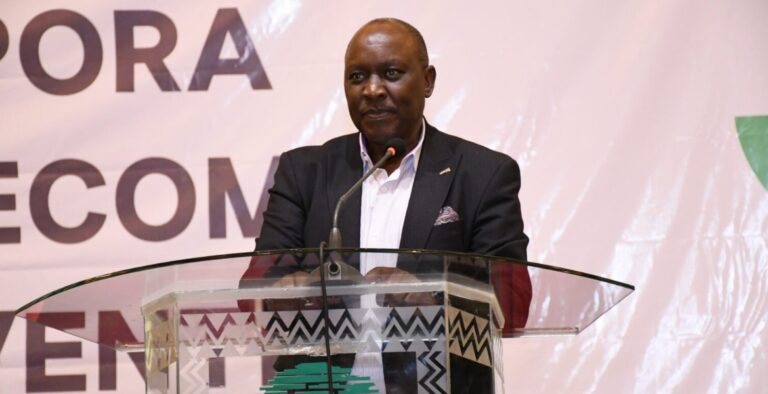
Children remain unattended at a county hospital ward, a grim reflection of Kenya’s healthcare crisis where understaffing leaves many fighting for their lives alone. Photo/DW
By Daisy Okiring
When you walk into a hospital, you expect care, healing, and hope.
But what happens when the very place meant to save lives becomes a death trap? Across Kenya, public hospitals are failing the very people they are meant to serve. Patients wait for hours—sometimes days—without seeing a doctor.
Underqualified trainees are left to handle critical cases. Essential drugs are out of stock, and even when available, they may be expired or counterfeit. Corruption, mismanagement, and an exodus of skilled medical professionals have turned Kenya’s healthcare system into a nightmare, where survival is no longer guaranteed.
Recent audits and reports paint a grim picture. In county hospitals across the country, understaffing is rampant, with doctors and nurses stretched beyond their limits. At Karatina Subcounty Hospital in Nyeri, for instance, the Senate Committee on County Investments and Special Funds found that the facility lacked essential services such as ICU, HDU, and renal dialysis. Meanwhile, at Kinango Subcounty Hospital in Kwale, there was a shortage of 44 medical professionals, including anesthesiologists, general surgeons, and pediatricians.
Read more: Over 200 hospitalised as mysterious illness spreads in Kisii
For many Kenyans, seeking treatment in a public hospital is a gamble. Some make it out alive—many don’t. “My mind is deeply perturbed by the recurring life-threatening events affecting our people,” laments one distressed citizen, recalling how her mother was misdiagnosed at Kitui County Referral Hospital and wrongly placed in a cast for a non-existent fracture. In another case, a retired teacher, Mwalimu Alice Ochami, was misdiagnosed with arthritis, leading to complications that left her bedridden for months.
But these are just a few stories among thousands. The reality is clear: Kenya’s public hospitals are in crisis.
A grim picture: The statistics speak for themselves
Kenya’s doctor-to-patient ratio is a shocking 1:17,000, far from the World Health Organization’s (WHO) recommendation of 1:1,000. Meanwhile, the country has only 13 nurses per 10,000 people, less than half the WHO-recommended 25 per 10,000. The Kenya National Union of Medical Laboratory Officers (KNUMLO) estimates that three out of every ten patients in Kenya are misdiagnosed, often leading to severe complications or death.
In a Johns Hopkins University study, medical errors rank as the third leading cause of death globally, with an estimated 251,000 deaths per year in the U.S. alone. While Kenya lacks precise data, the frequency of reported cases suggests the situation is dire.
At Karatina Subcounty Hospital in Nyeri, the facility is not even equipped to provide essential healthcare services under the Universal Health Coverage (UHC) system. Lacking an ICU, High Dependency Unit (HDU), and renal dialysis services, patients with serious conditions have nowhere to turn. The hospital is grossly understaffed, and mismanagement has led to missing medical supplies and underfunded departments.
Misdiagnoses and neglect: Stories of suffering
One of the biggest challenges plaguing Kenyan hospitals is misdiagnosis, a phenomenon that continues to claim lives. The tragic story of the late Bob Collymore, former Safaricom CEO, is an eye-opener. Initially diagnosed with a Vitamin D deficiency, he later discovered—too late—that he had stage four Acute Myeloid Leukemia.
Unfortunately, this is not an isolated case. Many Kenyans are misdiagnosed due to unqualified or overworked medical personnel. In Kakamega and Vihiga Counties, Hamptons Hospital and Coptic Hospital wrongly diagnosed a retired teacher with arthritis, triggering complications that left her bedridden for months.
Read more: Keroche chides Kihika for ‘mocking’ Nakuru residents
At Kinango Subcounty Hospital in Kwale, there is a shortage of 44 medical staff, including anesthesiologists, surgeons, and gynecologists. This means that critical medical procedures often go unattended, and emergency cases become fatal simply due to lack of expertise.
“We are forced to work double shifts, often handling cases beyond our expertise,” confesses a junior medical trainee at a county hospital. “Many times, senior doctors are unavailable, leaving us to make life-and-death decisions.”
A broken system: Drugs shortages, expired medicine and corruption
Public hospitals are grappling with a chronic shortage of essential drugs, with many patients forced to buy their own medication. Worse still, the drugs available in some hospitals are expired or counterfeit.

At Kwale County Referral Hospital, expired drugs worth millions of shillings were found in storage due to the failure of staff to follow proper inventory procedures. The hospital also suffered stock-outs of essential medicine for up to 117 days, leaving patients without treatment.
At Migori Level 4 Hospital, underfunding has led to inadequate medical supplies, severely compromising service delivery. The hospital suffered a funding shortfall of Ksh 32.86 million (27% of its budget) in the 2021-22 financial year. Meanwhile, at Longisa County Referral Hospital in Bomet, an unexplained Ksh 19.72 million was used for food purchases, with no records of receipts or accountability.

These financial irregularities further confirm that corruption in the healthcare sector is bleeding the system dry, while patients continue to suffer.
The exodus of qualified doctors and nurses
Kenyan healthcare workers are leaving the country in droves, seeking better pay and working conditions abroad. Recently, 2,500 nurses were recruited to work in Saudi Arabia, leaving an already strained system even more overwhelmed.
With poor wages, lack of protective equipment, and excessive work hours, many doctors opt to practice abroad, leaving unqualified or trainee doctors to fill the gap. This mass exodus is making an already bad situation worse.

“The conditions in county hospitals are unbearable,” says a nurse who recently relocated to Canada. “We work with little pay, zero equipment, and unrealistic patient loads. The government should prioritize improving local healthcare before exporting our professionals.”
Can Kenya fix this crisis?
There is an urgent need to increase funding for healthcare infrastructure to ensure hospitals are well-equipped with modern medical facilities, enough hospital beds, and sufficient medication. Alongside infrastructure investment, the government must prioritize hiring more doctors and nurses.
Offering competitive salaries and improving working conditions will help retain skilled professionals, reducing the brain drain that has left Kenya’s healthcare sector in crisis.
Another pressing issue is the need to strengthen medical training and supervision. Many junior doctors and medical students are left in charge of critical cases without proper guidance, leading to deadly mistakes. Senior professionals must be present to oversee and mentor younger staff, ensuring high-quality treatment and accurate diagnoses.
Read more: Breaking: Nation Media Group’s majority owner, the Aga Khan, dies at 88
Additionally, corruption and financial mismanagement within hospitals must be eradicated. Millions of shillings meant for medicine, equipment, and salaries disappear into the pockets of corrupt officials, leaving hospitals in dire straits. Transparency and accountability in healthcare financing are non-negotiable if meaningful reforms are to be realized.
Expanding public medical insurance is also crucial. With 75% of Kenyans lacking health insurance, millions cannot afford quality medical care. The proposed Social Health Insurance Fund (SHIF) must be effectively implemented to ensure every Kenyan can access healthcare without financial ruin. It is not enough for leaders to promise reforms; they must follow through with real action that prioritizes the well-being of ordinary citizens over political interests.
A call for urgent action
Kenyan public hospitals are no longer places of healing; they have become graveyards for the poor. Unless immediate reforms are undertaken, more lives will be lost to misdiagnosis, lack of medicine, and gross medical negligence.
It is time for the government, policymakers, and healthcare stakeholders to prioritize saving lives over political interests and corruption.
Because no Kenyan should walk into a hospital seeking treatment—only to leave in a coffin.



